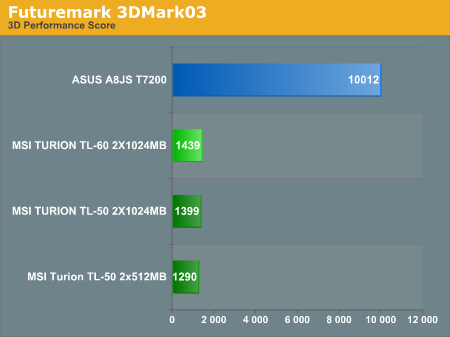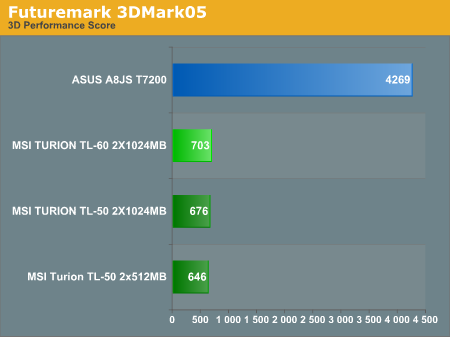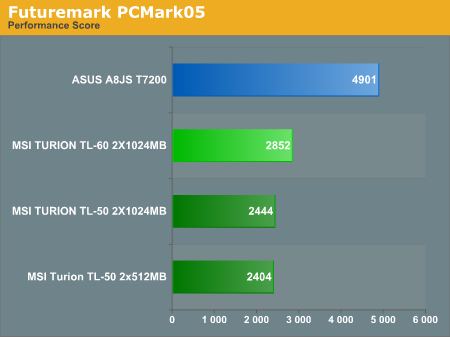MSI Megabook S271: a Look at AMD's Turion X2
by Jarred Walton on October 16, 2006 12:05 AM EST- Posted in
- Laptops
A Quick Look at Gaming/Graphics Performance
One area that we've mentioned a couple times but which we haven't actually addressed yet is the graphics performance of the two systems. We ran 3DMark03 and 3DMark05 on both laptops (3DMark06 requires SM3.0 support and as such was not able to fully run on the MSI notebook). We will also include PCMark05 performance here, simply because it fits in well with the rest of the Futuremark benchmarks. Because we are also interested in looking at how the Core 2 Duo compares to an equivalently clocked Turion X2, we would like to include the CPU results from both 3DMark applications, but the graphics chip has such a large impact on those scores that they are basically meaningless unless you have equivalent GPUs.



In the 3DMark tests, the MSI system's ATI Xpress 1100 IGP simply gets pummeled by the much more powerful GeForce Go 7700. The ASUS laptop is six times faster in 3DMark05 and seven times faster in 3DMark03, and it is also capable of running 3DMark06. PCMark05 also includes some graphics tests as part of the overall benchmark, and that combined with a faster hard drive accounts for the more than 70% performance advantage that the ASUS holds. As the earlier benchmarks showed, the Core 2 Duo T7200 is also faster than the Turion X2 TL-60, but the largest difference we saw earlier was around 40%, with the average performance advantage being closer to 30%.
As a final indication of how inadequate the ATI Xpress 1100 is when it comes to rendering modern 3D graphics, we ran our Half-Life 2: Lost Coast benchmark in both high quality and low quality graphics modes at 800x600 and 1280x800 resolutions. In the high-quality mode, we turned on all of the quality features, set anisotropic filtering to 8xAF, enabled HDR rendering, but left antialiasing disabled. For low quality graphics, we set all of the graphics options to the minimum, and we set the filtering level to trilinear. (We could have dropped it to bilinear filtering, but the performance difference wasn't noteworthy.)
The high-quality graphics mode certainly wasn't going to be playable by any stretch of the imagination, but single digit frame rates even at low resolutions should help give you an idea of how slow the IGP is, and the sad thing is that the Xpress 1100 is almost twice as fast as the Intel GMA950. Dropping to minimum quality graphics, we are still unable to get playable frame rates. 640x480 would be a bit faster, and if we disabled DirectX 9 support Half-Life 2 would probably become playable, at which point you might as well go back and play the original Half-Life -- that can be run on the MSI laptop without any problems.
There are other 3D games available that would actually perform better, but we can say for certain that Quake 4, Doom 3, F.E.A.R., Oblivion, and just about any other 3D game we've used in any recent article would not perform acceptably. Basically, the system provides the bare minimum of 3D graphics support that we would recommend these days and not much else. A lot of people don't need 3D graphics, so that's okay, but there are certainly other options available that include better graphics for a small increase in price. Unlike desktop systems, there's no way to add better graphics to many laptop computers, so just make sure you are absolutely certain you will never need 3D graphics performance (Windows Vista) before you purchase a new laptop that only includes an anemic IGP solution.
One area that we've mentioned a couple times but which we haven't actually addressed yet is the graphics performance of the two systems. We ran 3DMark03 and 3DMark05 on both laptops (3DMark06 requires SM3.0 support and as such was not able to fully run on the MSI notebook). We will also include PCMark05 performance here, simply because it fits in well with the rest of the Futuremark benchmarks. Because we are also interested in looking at how the Core 2 Duo compares to an equivalently clocked Turion X2, we would like to include the CPU results from both 3DMark applications, but the graphics chip has such a large impact on those scores that they are basically meaningless unless you have equivalent GPUs.



In the 3DMark tests, the MSI system's ATI Xpress 1100 IGP simply gets pummeled by the much more powerful GeForce Go 7700. The ASUS laptop is six times faster in 3DMark05 and seven times faster in 3DMark03, and it is also capable of running 3DMark06. PCMark05 also includes some graphics tests as part of the overall benchmark, and that combined with a faster hard drive accounts for the more than 70% performance advantage that the ASUS holds. As the earlier benchmarks showed, the Core 2 Duo T7200 is also faster than the Turion X2 TL-60, but the largest difference we saw earlier was around 40%, with the average performance advantage being closer to 30%.
As a final indication of how inadequate the ATI Xpress 1100 is when it comes to rendering modern 3D graphics, we ran our Half-Life 2: Lost Coast benchmark in both high quality and low quality graphics modes at 800x600 and 1280x800 resolutions. In the high-quality mode, we turned on all of the quality features, set anisotropic filtering to 8xAF, enabled HDR rendering, but left antialiasing disabled. For low quality graphics, we set all of the graphics options to the minimum, and we set the filtering level to trilinear. (We could have dropped it to bilinear filtering, but the performance difference wasn't noteworthy.)
| Half-Life 2: Lost Coast (FPS) | ||||
| Happy Halloween! | 800x600 LQ | 1280x800 LQ | 800x600 HQ | 1280x800 HQ |
| MSI TL-50 2x512MB | 17.49 | 11.79 | 8.57 | 4.34 |
| MSI TL-50 2x1024MB | 18.19 | 12.26 | 8.94 | 4.54 |
| MSI TL-60 2x1024MB | 19.12 | 12.56 | 9.13 | 4.59 |
The high-quality graphics mode certainly wasn't going to be playable by any stretch of the imagination, but single digit frame rates even at low resolutions should help give you an idea of how slow the IGP is, and the sad thing is that the Xpress 1100 is almost twice as fast as the Intel GMA950. Dropping to minimum quality graphics, we are still unable to get playable frame rates. 640x480 would be a bit faster, and if we disabled DirectX 9 support Half-Life 2 would probably become playable, at which point you might as well go back and play the original Half-Life -- that can be run on the MSI laptop without any problems.
There are other 3D games available that would actually perform better, but we can say for certain that Quake 4, Doom 3, F.E.A.R., Oblivion, and just about any other 3D game we've used in any recent article would not perform acceptably. Basically, the system provides the bare minimum of 3D graphics support that we would recommend these days and not much else. A lot of people don't need 3D graphics, so that's okay, but there are certainly other options available that include better graphics for a small increase in price. Unlike desktop systems, there's no way to add better graphics to many laptop computers, so just make sure you are absolutely certain you will never need 3D graphics performance (Windows Vista) before you purchase a new laptop that only includes an anemic IGP solution.










31 Comments
View All Comments
JarredWalton - Monday, October 16, 2006 - link
First, the "closed system" as such is not something we would recommend. Dual core with only 512MB of RAM? I already covered that. Second, the system *is* available as a barebones (MSI MS-1058), as I mentioned in the review. Memory compatibility aside, this isn't a great laptop. It's okay.The memory issues are something worth mentioning, even if we got them worked out. Even if everything had worked without issue, the laptop would have still only been okay - there are quite a few competing notebooks in the same price range, and this one fails to stand out from the crowd in any meaningful way.
Furen - Monday, October 16, 2006 - link
Sounds like you had huge memory compatibility problems, though. Personally, I always buy Crucial because when I used to buy other RAM (Kingston, etc), more often than not, I had some sort of memory compatibility problems (probably because I mixed brands but I've never had ANY problems at all with Crucial stuff).DrMrLordX - Monday, October 16, 2006 - link
I know the Core Duo is now an old product that is being replaced by the Core 2 Duo in the mobile sector, but it would have been nice to see the Turion X2 benchmarked against a Core Duo laptop as well. Surely a similarly-configured Core Duo machine exists out there somewhere.IntelUser2000 - Monday, October 16, 2006 - link
One thing is the Core 2 Duo laptop has 7200RPM HDD while the Turion X2 has 5400RPM. It shouldn't impact is greatly but it'll make a difference.IntelUser2000 - Monday, October 16, 2006 - link
Uhh. No. Clearly no. Explanation?? Turion X2 system uses integrated graphics, while Core 2 Duo system uses a powerful video card. Do you guys really think idle power of video card+chipset is equal to chipset alone??
IntelUser2000 - Monday, October 16, 2006 - link
http://www.computerbase.de/artikel/hardware/grafik...">http://www.computerbase.de/artikel/hard...hnitt_le...Integrated graphics power is clearly lower than even super low-end discrete. Now on this AT review we are talking about a mid-range part.
Sorry for triple post, but I must get my point across.
Two laptops, each possessed by one of my friends, both a Dell:
Pentium M 765 2.0GHz/533MHz FSB
1GB DDR2-533
120GB 5400RPM HDD
Geforce Go 7800GTX 128MB
15.4 inch wide-screen
70WHr battery
2.5 hour battery life with internet surfing, usage
2. Pentium M 1.6GHz/400MHz FSB/Dothan
512MB DDR2-533
Intel GMA900
60GB 4200RPM HDD
14 inch screen
45WHr battery
3.5 hour battery life with internet surfing, light usage
Is there a reason some high-end laptops are featured with integrated/discrete graphics card option?? You can turn one off?? Cause video cards in laptops suck huge amounts of power.
JarredWalton - Monday, October 16, 2006 - link
There are multiple issues involved with testing comparable laptops. Short of going out and purchasing a laptop, it's very difficult to pull off. At this point, there's not much reason to get a Core Duo notebook instead of a Core 2 Duo notebook, other than price. So we're doing our best to compare laptops that are similar, and we wanted to get this review out the door before it got any older. Obviously, we're still not recommending the MSI S271 over other laptops.In regards to Inteluser2000, he makes several comments. I have now reworded the page on power consumption to clarify a few points. However, not all of his points are entirely valid either. For example:
I don't think he was reading clearly, because I had just explained that at maximum CPU load MSI Turion X2 is consuming MORE power than ASUS Core 2 Duo. In other words, even with integrated graphics versus discrete graphics and with all of the other variables involved (7200 RPM hard drive versus 5400 RPM Drive, 14 inch LCD versus 12.1 inch LCD, etc.), without putting a load on the GPU one would expect the ASUS system to draw more power than the MSI system, and it doesn't. At idle, all of the variables can explain why the ASUS consumes more power, but when I put 100% load on just the CPU Turion X2 clearly requires more power.
I have no idea what he is trying to say with his comment about Dell laptops. Comparing a high-end system with a GeForce Go 7800 GTX to one that uses IGP is far worse than comparing something that uses GeForce Go 7700 to IGP. Different battery sizes, different display sizes, different processors, different hard drives, memory, etc. -- of course they're going to have different results. However, in this case are not drawing any final conclusions about idle power, other than to point out some interesting trends. What I am concluding is that if we were able to isolate just the CPU power use, a Turion X2 TL-60 at 100% load would require a lot more power than a Core 2 Duo T7200 at 100% load.
The ASUS system is there more as a frame of reference, particularly on the power requirements page. I really can't say for certain whether Turion X2 uses more power or less power at idle, but I am positive that it requires more power when it's placed under 100% load. Hope that explains things.
IntelUser2000 - Monday, October 16, 2006 - link
Nonono. I don't care about the load power, I care about your conclusions regarding idle. Even if you don't put load on the GPU, it consumes power. In laptop standards, lots of power. Its not a coincidence some laptop manufacturers put dual video card solutions(integrated/discrete), because they realize discrete cards affect battery life in idle, not just load. What I don't like is the explanation that its the CPU and chipset that contributes to idle power consumption and less battery life at DVD playback, Mobilemark, etc.
Check this out: http://www.trustedreviews.com/article.aspx?page=50...">http://www.trustedreviews.com/article.aspx?page=50...
(Dual GPU machine)
DVD playback
IGP: 164 minutes
Nvidia Geforce Go 6600: 112 minutes
MobileMark 2005 general battery life test
IGP:128 minutes
Geforce Go 6600: 92 minutes
30-40% battery life difference. Looks like video card is quite a big drain on battery life. I bet significant battery life difference between my friend's two system lies in the video card.
This is really a laptop review rather than a CPU review. Of course, due to laptops peculiarity of outperforming one with what looks like similar specifications, the idea of a CPU comparison on a laptop is far-fetched.
JarredWalton - Monday, October 16, 2006 - link
I did reword the rest of the page in regards to power use. I have used an ASUS W5F and found that it used about the same amount of power as the S271 (at idle). It was slightly more, so the remaining conclusions (i.e. Turion X2 in low power mode uses a bit less power) seem to be consistent. Tough to say 100% without nearly identical laptops - and you still have chipset and mobo components that can have an impact.IntelUser2000 - Monday, October 16, 2006 - link
You can find otherwise similar looking laptops that have different power consumption. How did you test out the W5F?? Just dropped in a Core 2 Duo in replacement of Core Duo?
Otherwise nice test.